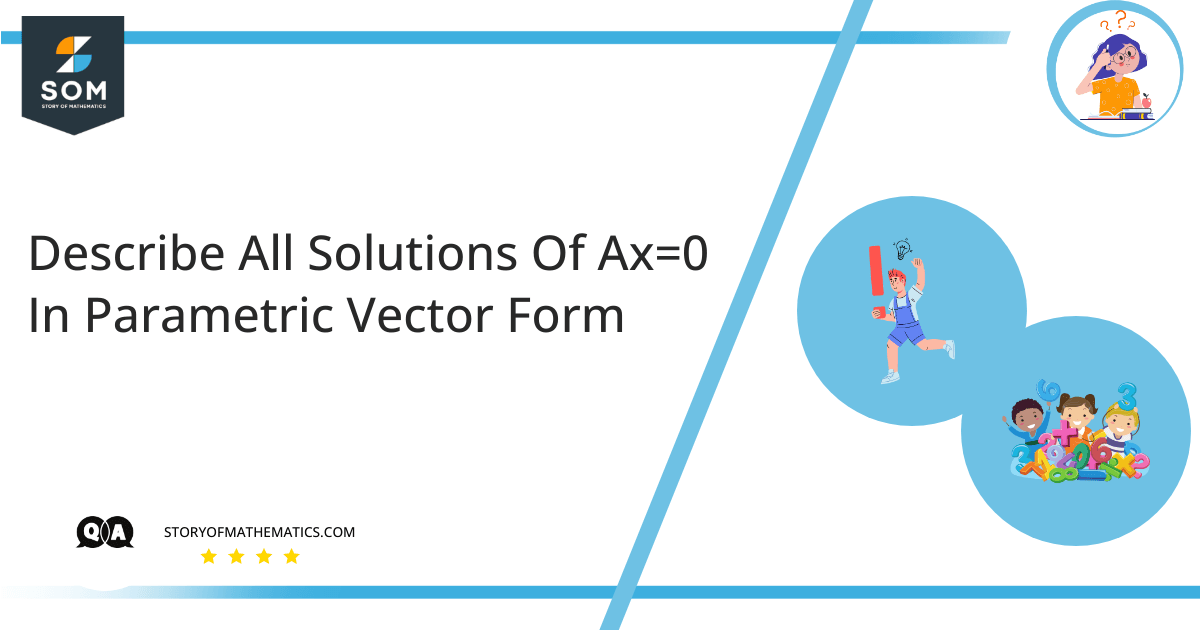
This problem aims to get us familiar with vector solutions. To better understand this problem, you should know about the homogeneous equations, parametric forms, and the span of vectors.
We can define parametric form such that in a homogeneous equation there are $m$ free variables, then the solution set can be represented as the span of $m$ vectors: $x = s_1v_1 + s_2v_2 … s_mv_m$ is known as a parametric equation or a parametric vector form. Usually, a parametric vector form utilizes the free variables as the parameters $s_1$ through $s_m$.
Expert Answer
Here, we have a matrix where $A$ is the row equivalent to that matrix:
\[ \begin{bmatrix} 1&3&0&-4 \\ 2&6&0&-8 \end{bmatrix} \]
Given matrix can be written in Augmented form as:
\[ \left[ \begin{array}{cccc|c} 1&3&0&-4 & 0\\2&6&0&-8&0\\ \end{array} \right] \]
Row Reduced Echelon Form can be obtained using the following steps.
Interchanging the rows $R_1$ and $R_2$.
\[ \left[ \begin{array}{cccc|c} 2&6&0&-8&0 \\ 1&3&0 &-4 & 0 \\ \end{array} \right] \]
Applying the operation $R_2 \rightarrow 2R_2 – R_1$, to make the second $0$.
\[ \left[ \begin{array}{cccc|c} 2&6&0&-8&0\\1&3&0&-4&0 \\ \end{array} \right] R_2 \rightarrow 2R_2 – R_1 \]
\[ \left[ \begin{array}{cccc|c} 2 & 6 & 0 & -8 & 0 \\ 0 & 0 & 0 & 0 & 0 \\ \end{array} \right] \]
Dividing the first row by $2$ to generate $1$ at the ….
\[ \left[ \begin{array}{cccc|c} 2&6&0&-8&0\\0&0&0&0&0\\ \end{array} \right] R_1 \rightarrow \dfrac{1}{2} R_1 \]
\[ \left[ \begin{array}{cccc|c} 1&3&0&-4&0 \\ 0&0&0&0&0 \\ \end{array} \right] \]
From here following equation can be deducted as:
\[ x_1 + 3x_2 – 4x_4 =0 \]
Making $x_1$ the subject of the equation:
\[ x_1 =- 3x_2 + 4x_4 \]
Hence, $Ax=0$ parametric vector form’s solutions can be written as:
\[ x = \left[ \begin{array}{c} -3x_2+4x_4\\x_2\\x_3\\x_4\\ \end{array} \right] = \left[ \begin{array}{c} -3x_2\\x_2\\0\\0\\ \end{array} \right] + \left[ \begin{array}{c} 0\\0\\x_3\\0\\ \end{array} \right] + \left[ \begin{array}{c} 4x_4 \\ 0 \\0\\x_4\\ \end{array} \right] = x_2 \left[ \begin{array}{c} -3 \\1\\0\\ 0 \\ \end{array} \right] + x_3 \left[ \begin{array}{c} 0\\0\\1\\0\\ \end{array} \right] + x_4 \left[ \begin{array}{c} 4\\0\\0\\1\\ \end{array} \right] \]
Numerical Result
\[ x = x_2 \left[ \begin{array}{c} -3 \\ 1 \\ 0 \\ 0 \\ \end{array} \right] + x_3 \left[ \begin{array}{c} 0 \\ 0 \\ 1 \\ 0 \\ \end{array} \right] + x_4 \left[ \begin{array}{c} 4 \\ 0 \\ 0 \\ 1 \\ \end{array} \right] \]
Example
Find all the possible solutions of $Ax=0$ in parametric vector form.
\[ \begin{bmatrix} 1 & -2 & -9 & 5 \\ 0 & 1 & 2 & -6 \end{bmatrix} \]
Row Reduced Echelon Form can be achieved as:
\[ \left[ \begin{array}{cccc|c} 1 & 0 & -5 & -7 \\ 0 & 1 & 2 & -6 \\ \end{array} \right] \]
From here following equation can be deducted as:
\[ x_1 =5x_3 + 7x_4 \]
\[ x_2 =-2x_3 + 6x_4 \]
where the $x_3$ and $x4$ are free variables.
We get our final solution as:
\[ s \left[ \begin{array}{c} 5\\-2\\1\\0\\ \end{array} \right] + t \left[ \begin{array}{c} 7\\ 6\\0\\1\\ \end{array} \right] \colon s,t \in \mathbf{R} \]
